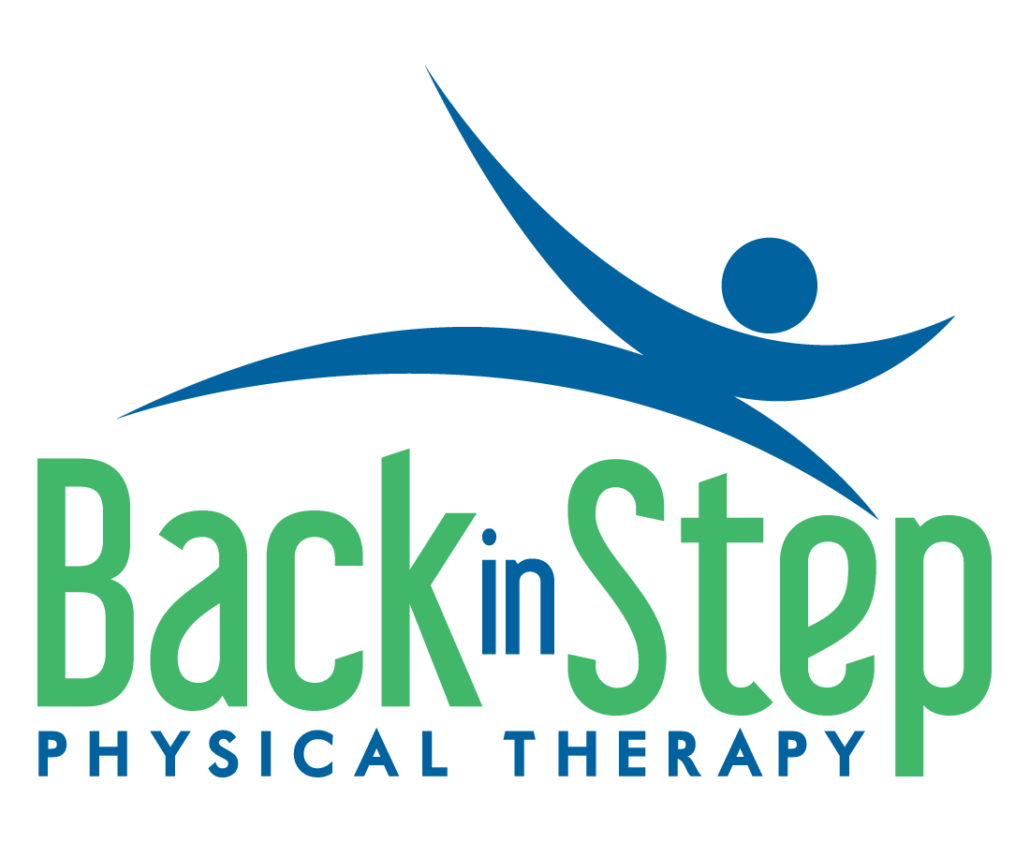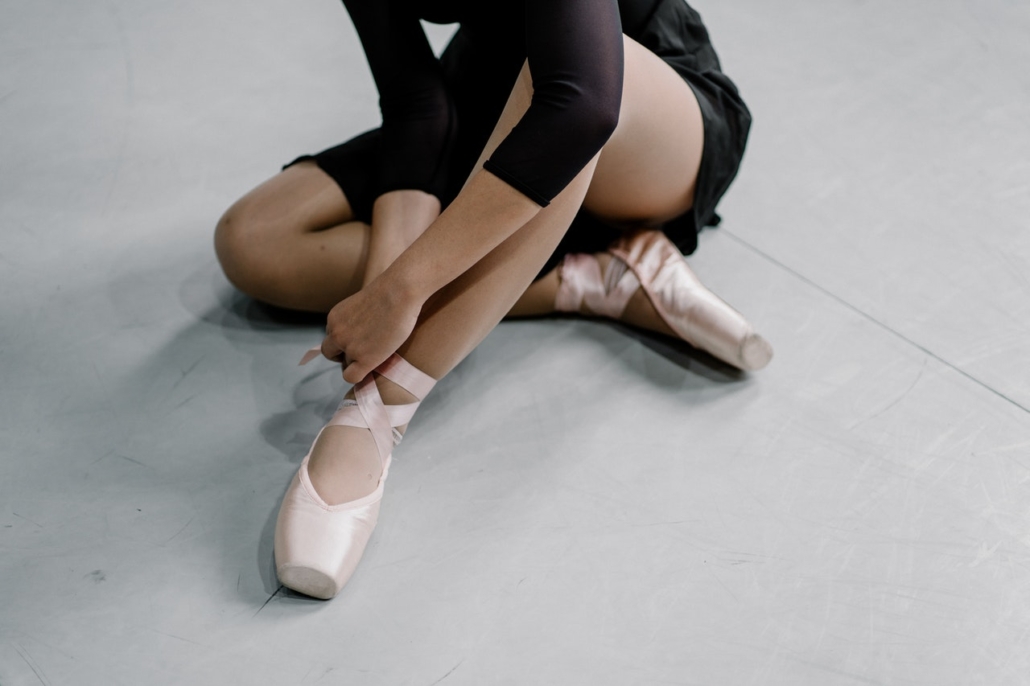More About Your Pointe Shoe
/in The Performing Arts, Uncategorized /by Dr. Alyssa Arms, PT, DPT, OCSFinding the right pointe shoe is a major part of a ballet dancer’s life. We learn how to sew the ribbons & elastics. We build relationships with our fitter, who may be local, fitting virtually, or a long trip away. We learn how to start dancing in the shoes, refining our technique.
With everything that we do learn when it comes to pointe, there are some things that we don’t really talk about or learn about. Keep reading to find out.
EXTENDING THE LIFE OF THE SHOE
Most dancers who dance en pointe should be doing at least a couple of hours of ballet per week, some of which will include pointe work. We all know that when we’re working, feet get sweaty. That moisture builds up in the shoes and can start to contribute to the breakdown of the material inside of a pointe shoe.
Watch the fascinating way pointe shoes are made in the video above.
If you’re only doing pointe for short periods 1-2 times per week, you probably get plenty of time for the shoes to dry out between uses, keeping your shoes in good shape for longer.
But if you’re dancing in the same shoes for multiple hours a week, you may want to consider having more than one pair of shoes to let each one have a chance to full dry between uses.
DIFFERENT POINTE SHOES FOR A DIFFERENT GOAL
Dancers are often on the hunt for the elusive “perfect fit” of their pointe shoes. It can take several tries of different brands, styles, and shoe characteristics to find what fits best.
But did you know that there can be more to it than that?
If you’re dancing en pointe quite a bit, it may actually be beneficial to have more than one pair of pointe shoes, not just for what we talked about in the section above. You may want a different shoe for different uses (performance vs class) or to let you work on different things (foot or core strengthening vs balance).
It’s not just about fitting the shoe to the foot – although that definitely is an important part!

Let’s first talk about a couple of scenarios that you might encounter.
If you’re performing in a ballet with quite music, you don’t want loud shoes that you’ll hear from a mile away. You’d want something lighter, perhaps with a softer shank or a different material. Maybe you want a box that’s a bit more broken in. More pleats or a shoe that has a foam-like material built in can also help the shoe be quieter.
For a piece that requires a lot of pirouettes and balance on pointe, a harder shoe with a more substantial platform is helpful, as you’ll get more support.
Choose a shoe that best serves your purposes for a given performance or audition.
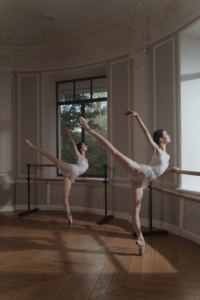
Now let’s talk a bit about how a couple of different shoe characteristics help you build strength, gently return to dance after an injury, or something else. These are just a few examples. Each element of a pointe shoe has its pros and cons for an individual dancer.
THE PLATFORM
A small platform is the hardest to balance on but requires less strength for rotation on the platform. Meanwhile, a large platform is easier to balance one but requires more strength for rotation.
A platform with rounded edges is easier to roll through smoothly but it’s harder to find the center of the box for balancing. This decrease in stability can more other muscles in the body, like around the hips & core, work harder to maintain alignment. A flat platform essentially has the opposite effect.
Then there are tilted platforms. These are fine if you have strong ankles. They’re not a good choice if your feet are more flexible or still need to build strength.
THE SHANK
A soft shank tends to be lighter and therefore quieter but don’t give as much support and are more likely to break in quickly. These shoes may be a good choice for a show, for example.
On the opposite end of the spectrum, a hard shank tends to be heavier and lower, but last longer. These are good for something like classes – able to hold up longer and get more wear.
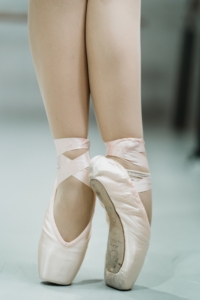
WORK WITH A PROFESSIONAL
At the end of the day, there are a LOT of things that need to be considered when it comes to finding the right pointe shoe.
You want something that feels comfortable and gives you the right support in the right areas. A good fitter will also consider things like foot structure or medical diagnoses. This could include bunions, more flexible feet, or whatever the case may be.
Talk with your fitter. Let them know if you’re struggling with an aspect of your current shoes. Let them know if you’re still returning from an injury. Talk about needing a quieter shoe for an upcoming performance. They’ll give you recommendations to find the right shoe for you and for your specific needs, whatever they may be.
You may also find some dance specialists in the health and wellness world, like Dr. Alyssa here at Back in Step PT, who have had training in at least the basics of pointe shoe fitting. These individuals can also make suggestions about certain characteristics to consider or to discuss with your fitter.
Book a session with us at Back in Step PT!
Hypermobility & Dancers
/in Health & Wellness, The Performing Arts, Uncategorized /by Dr. Alyssa Arms, PT, DPT, OCSCNN recently published a wonderful article about hypermobility and, more specifically, a diagnosis called Ehlers Danlos Syndrome.
Hypermobility is something often seen in the dance community, and all too often, it’s undiagnosed.
What is hypermobility?
Generally speaking, hypermobility just means that the joint moves more than what is expected. This is completely normal for little kids, whose flexibility decreases as they get older.
But that’s expected. It’s when we’re seeing that beyond early childhood that we start to get more interested.
These individuals may be more flexibile, bendy, or say they’re double-jointed. People can be extra flexible and have no other symptoms. Others may have a list of things that go along with it.
Hypermobility in Adolescents & Adults
There are many different types of hypermobility, some of which have genetic component Some types have impacts like bone fragility (osteogenesis imperfecta) or changes in facial struction (stickler syndrome), for example.
Others have joint hypermobility as the main focus, but certainly not as the other symptom. These include categories like Hypermobility Spectrum Disorder, Joint Hypermobility Syndrome, and Hypermobile Ehlers-Danlos Syndrome.
For this group of diagnoses, hypermobility is just one piece of the puzzle. Often times, though, these individuals may expierence things like:
- Chronic fatigue
- Headaches
- Bruising easily or trouble healing wounds
- Stomach & digestive problems
- Bowel & bladder problems
- Autonomic dysfunction, including postural tachycardia syndrome (POTS), dizziness, fainting, etc.
- Mast cell activation syndrome (MCAS), which includes allergy-type symptoms
Many other symptoms or presentations may exist within the different types of hypermobility disorders, but the list above are some of the more common ones.
Hypermobility in Dancers
It can be challenging to identify some of our dancers with hypermobility, especially since dance is a sport & art form that often demands flexibility and is a big part of training.
These dancers may say that they work on stretching all the time but they still feel tight. They may also be a dancer who gets injured often or has health issues frequently.
Common injuries related to joint instability are be hyper-extension sprains or strains, joint subluxations or dislocations.
These may also be the dancers that have trouble with coordination or certain technique. With unstable joints, it’s harder to get good information from their proprioceptive system – the one that tells our brain where each part of our body is in space. That lack of good information means the dancer isn’t aware of how pointed their foot is or have trouble balancing, for example.
A dancer with hypermobility (diagnosed or not) may have their dance careers impacted by the joint instability or other symptoms. It is helpful to get the diagnosis and the support to help manage it.
Common Challenges
Hypermobility disorders, especially ones like Ehlers-Danlos (EDS), often go way too long without a diagnosis. It’s all too common to hear stories about people getting diagnosed in their 40s or 50s, seeing doctors for years for the various symptoms, and experiencing so much frustration.
With some of these diagnoses, other life-affecting problems abound, like gut issues, allergy-like symptoms, anxiety & other mental health issues – the list goes on.
According to the Ehlers-Danlos Society, the average time to diagnosis can be 10-12 years. One study also showed that 20% of EDS patients have seen more than 20 doctors while trying to get a diagnosis.
Why this is important
Although there currently is no cure for EDS or other hypermobility disorders, there are things that can be done to support those with the diagnosis.
There are a growing number of resources available to help, including specialists who focus in this area. These specialists can help with supportive nutrition plans, ways to work on physical health while maintaining joint safety, and so much more.
At Back in Step PT, we’ve seen many cases of young dancers with suspected or diagnosed hypermobility disorders. We’re hear to support you and help you get some answers.
Is Your Dancer Ready for Pointe? A Guide for Parents
/in The Performing Arts, Uncategorized /by Dr. Alyssa Arms, PT, DPT, OCS It seems like one of the biggest things for young dancers growing up is the dream of dancing en pointe. And why not?! You get to have the beautiful shoes, the gorgeous tutus, and the chance to develop a whole new set of skills.
It seems like one of the biggest things for young dancers growing up is the dream of dancing en pointe. And why not?! You get to have the beautiful shoes, the gorgeous tutus, and the chance to develop a whole new set of skills.
This dream of dancing en pointe is great and a good goal to have, but some dancers or dance parents may be eager to start pointework before their teacher has made the recommendation. It may feel unfair that a dancer doesn’t get to start yet. Or maybe you’re not sure why the teacher is/isn’t giving a recommendation.
The goal of this post is to talk a little bit about what your dancer needs to have, from a medical perspective, to safely dance en pointe. We’ll also be addressing some of the myths around readiness and additional considerations.
Myth #1: You can automatically move to pointe once you reach a certain age.
FACT: Age is only one small part of everything that should be considered. Most recommendations from medical research suggest that the dancer is at least 12 years old – or maybe 11, in certain specific circumstances.
Why is that? A big part of it has to do with development of bones and joints.
We know that the bones of the foot finish developing someting between the late teens to early twenties, but it varies a lot from person to person. Besides that, we are also concerned about the dancer’s growth plates. This is the part of the bone (like the femur, or thigh bone) where a child’s growth happens. These close around 14 years old in females. We want to be closer to that age before starting pointe.
Myth #2: You can progress to pointe once you reach a certain level at your studio.
FACT: The truth is – this is partially true.
It’s not so much about reaching a certain level. This makes sense because different studios or training programs have different definitions of their levels, so it’s hard to compare from program to program.
The biggest recommendation here is actually related to amount of training. Generally, we recommend 3-4 years of ballet-specific training. This means that other dance styles or mixed classes (like a ballet/tap combo class) do not count towards that total. Some recommendations even say that it should be 3-4 years after the age of 8!
Besides the recommendation of 3-4 years, we also recommend 2-3 hours of ballet classes per week.
Myth #3: Once you’re on pointe, there no need to ever go off again, except if you have a major injury.
FACT: Of course injury or pain is an excellent reason to take a break from pointe! But we want to challenge you to think about another time when it may be beneficial.
Consider also taking a temporary break when the dancer is going through a growth spurt. During this time, the muscles and strength, as well as control and coordination, are all trying to catch up with one another. We even know that some muscles need to work up to 40% harder during this time, at least until everything is back on the same track.
During this time, dancers can focus on developing their strength and control again. They can continue working on demi-pointe and can focus on a strengthening program. Once they’re feeling more coordinated again and aren’t experiencing some of the growing pains, it can be safe to work back into their pointe work.
Hopefully this helps dispel some of the most common rumors about when dancers are or aren’t ready for pointe!
Now for some additional considerations:
-
What does the research say?
 An interesting fact: working on demi-pointe puts up to 4 times your body weight through your foot. Once you’re working on full pointe, it can put up to 12 times your body weight through your foot! That is yet another reason why it’s crucial that dancers are truly ready for pointe and not starting too early.
An interesting fact: working on demi-pointe puts up to 4 times your body weight through your foot. Once you’re working on full pointe, it can put up to 12 times your body weight through your foot! That is yet another reason why it’s crucial that dancers are truly ready for pointe and not starting too early.
There are some tests that your dance teachers and/or dance medicine professional can do to assess readiness even more specifically (and we highly recommend this).
Some easy ones to do in the studio are things like the pencil test, airplane test, topple test, and single leg sauté test.
Besides that, it’s also great to have some strength and joint motion test done, which can be done by a dance medical professional. For a very thorough assessment, we also recommend the medical professional look at things like injury history, training habits, general health, nutritional practices, and more.
-
Should my dancer get an xray to check their growth plates?
No. You may often hear this recommendation from dance instructors but research actually shows little evidence that this is helpful information. Seeing the growth plate “closed” on the xray does not necessarily mean that the bones are mature.
So if you do get the xrays done, not only is it not the most reliable information, but you’re spending money on it and your dancer is getting exposed to radiation unnecessarily.
-
When should we seek out a dance medicine professional?
If your dancer:
-
-
- is complaining of pain for longer than a week, or it is accompanied with swelling, loss of joint motion, numbness, or instability.
- has pain that wakes them up at night, is present at the start of activity, or gets worse with activity.
- seems to be frequently injured or if they seem to take a long time to recover.
- is showing an imbalance in flexibility, strength, or control from side to side.
- is hyperflexible.
-
And, of course, seek out a dance medicine professional for things like pointe readiness assessments, annual dancer physicals, injury screenings, fitness programs, and other prevention and wellness services. Find out more about ours here.
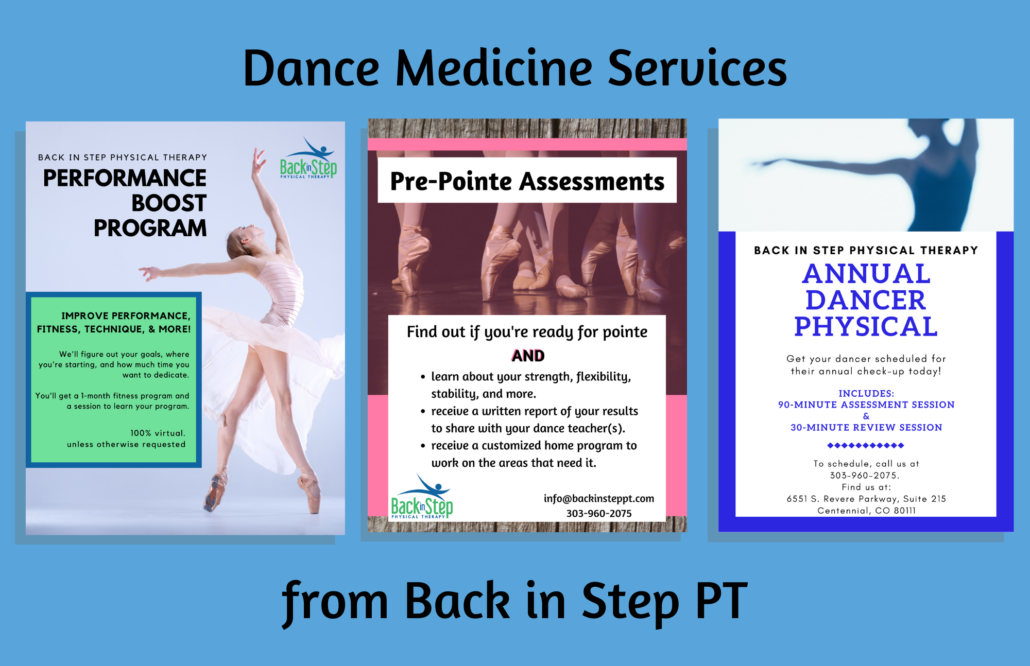
Check out our video about it on our YouTube channel!
Back in Step with Steady Nutrition
/in Corporate Wellness, Health & Wellness, The Performing Arts, Uncategorized /by Dr. Alyssa Arms, PT, DPT, OCS“Eat less. Eat more. Cut carbs. Add fats. Take away fats. Crash diet. Water weight. Hydrate. Substituting. Try dark chocolate. Pile on the veggies!”
 Many of us have heard these words and phrases thrown around when it comes to nutrition. I don’t know about you guys, but all of the conflicting information found online can be really confusing to navigate. There are so many people advocating for fad diets and quick fix solutions on social media, but what do you try and what will really work for you in the long run? How do you find the right way to adjust your lifestyle to consistently maximize nutrition, lose weight, add muscle, sleep better, increase energy and performance, and just feel healthier?
Many of us have heard these words and phrases thrown around when it comes to nutrition. I don’t know about you guys, but all of the conflicting information found online can be really confusing to navigate. There are so many people advocating for fad diets and quick fix solutions on social media, but what do you try and what will really work for you in the long run? How do you find the right way to adjust your lifestyle to consistently maximize nutrition, lose weight, add muscle, sleep better, increase energy and performance, and just feel healthier?
Lets explore some of these topics by addressing what nutrition is and how to consistently get it.
Nutrition: What is it?
Take a second and think about what you know about healthy food choices. What comes to your mind regarding the word nutrition?
Did you picture broccoli and kale? Or apples and grapes? Or maybe memory came up about “healthy dieting”? You probably have a lot of knowledge about what is healthy and what is not. You know your body and what helps you have energy and what makes you feel slow. Or maybe you’ve even grown-up with parents expressing that fruits and vegetables are good, and that sugar and fried food are bad. Let’s keep expanding this idea by diving into the details of nutrition.
Nutrition is simply “the process of obtaining food that is necessary for health and growth.” It is the intake of food that nourishes your body and mind. This process can seem confusing if we don’t even know where to start or what food are good for your body.
Essential Foods for a Healthy Body
Here is a list of 6 food types that are essential to nourish your body and help keep you healthy. Explore these items the next time you are at the grocery store. Maybe even try adding in a few of these examples for a nutritious, balanced plate.
- Vegetables and fruits.

You guessed it. Veggies and fruits are super nutritious foods that contain a lot of natural vitamins
to help your body function, grow, and work to its best ability. There are 13 vitamins are considered essential nutrients that we can only get from eating food, and many of them are found specifically in veggies and fruits. These guys are also high in fiber, which helps keep your gut from getting blocked up and bloated. By incorporating fruits and veggies, you may reduce inflammation in your body, which could even decrease chronic pain levels!
A few good rules of thumb to keep in mind:

-
- Different colors of fruits and vegetables contain different vitamins. Try for a variety of colors to eat to get all 13 essential vitamins.
- Shoot for dark leafy greens and fruits that are colorful on the inside. They carry more than one vitamin.
- Work toward adding in 5 portions of fruits and veggies a day.
- Consider adding a multivitamin to your diet in the beginning as you are getting used to this new addition. (Consult with your primary care physician to find out if this is a good option for you).
- Healthy Fats.

Yeah, you need fats for body to work well. Your brain functions best with healthy fats because they
help with making your nerve pathways faster. Your body also needs them to absorb minerals and vitamins A, D, E and K (4 out of the 13 essential nutrient vitamins). Fats also make up a large portion of your cells and are important for new cell growth (for healthy skin and nails), blood clotting for when you have an injury, and they supply energy for sustained muscle movement.
Some ideas for healthy fats are “omega-3 and omega-6 fatty acids” found in chia seeds, nuts, fish, and olive oil. Try to limit unhealthy trans or hydrogenated fats like butter, processed peanut butter, fatty red meat (burgers and pork) and processed soft cheeses.
- Essential minerals.
These are nutrients you get from food like calcium, iron, phosphorus, potassium, sodium, and magnesium. Minerals are important to help your bones grow and allow for your brain to work fast and efficiently to form thoughts. They also help with muscle control, nerve action, and heart and organ health.
You can get these essential minerals by eating fish, a variety of dark vegetables and colorful fruits, beans, seeds, nuts, fish, and grains like rice and cereals.
- Proteins.

Proteins are wonderful nutrients for building muscle and for helping your hair, skin, nails
, and bones. They are made up of “essential amino acids” which are the building blocks of proteins. You need to get all of these amino acids for your body to grow muscles and to repair itself after work outs.
Animal meat contains all essential amino acids. Try for lean meat to control healthy fat intake. Examples of healthy meat include eggs, fish, chicken breast, and lean steak.
You can also get protein and essential amnio acids with eating a combination of plant sources like whole grains, nuts, legumes, and vegetables.
- Carbohydrates.

Yes! Carbohydrates are essential for proper nutrition! Good carbs supply your brain and body with momentum throughout the day. They are the nutrient that burns the fastest to supply you with energy, and they are especially important for fueling your working out and homework brain power. However, don’t go eating that donut quite yet. Carbohydrates that are also full of fiber and have high water content will supply you with immediate energy and also help you feel full longer.
Fruits are a great source of carbohydrates due to their sugar content. Many of them also have fiber which helps you feel satisfied and less hungry for longer bouts of time. Oats, quinoa, and whole grains are also great sources of carbohydrates that supply energy and keep you full.
- Water.

Last, but certainly not least, is water! Hydration is vital for a healthy body, after all, we are made up of roughly 60% water. Dehydration can lead to cramps, nausea, lightheadedness, fainting, and poor performance with athletic activities.
Daily recommendations is to drink half of your body weight in ounces. This means if you weigh 200 pounds, you need to drink 100 ounces of water every day. You can track this with easy and free apps on your phone like: Plant Nanny, My Water Balance, or Daily Water Tracker.
With athletic activity, shoot for drinking 15-20 ounces of water 1-2 hours before you start exercising. Make sure to stay hydrated while you exercise by drinking 8 ounces of water every 15 minutes (it helps with regulating your temperature during activity). Be sure to avoid carbohydrate drinks and large amounts of sugary fruit juice, because these can be counterproductive. At the end of working out, replenish all of the liquid you lost through sweat by drinking at least 8 to 10 ounces of water within 30 minutes after activity.
Check out our Back in Step PT Pinterest for some healthy recipe ideas by Dr. Alyssa Arms, DPT.
Consistency for Long Term Results
You now know all of this information about nutrition. You know what you “should” add into your daily meals. Now what?
The matter of fact is that consistency is difficult to achieve, especially when forming new dietary habits. It also looks different for everyone. What worked for your friend or family member may not work for you. So let’s take a deeper dive into your individual life and explore some factors to help you get started with consistency when it comes to getting proper nutrition.
First off, I would like to take a moment and thank you for showing up for yourself. If you are on this page, it means you are putting your health and nutrition first. It means there is a part of you that may be willing to make a step toward change.
Thoughts to Consider
I want to encourage you to take a moment to reflect on your relationship with food and nutrition and write down your thoughts to these questions:
- What is your goal for your health related to nutrition?
- Do you have any concerns about accomplishing your goal?
- Which concern is the most important and why?
- What do you want to change?
- How do you specifically want your eating habits to be different?
- What has worked for you in the past?
- What has not worked and what did you learn?
- Has there been anything to block you from your goal in the past?
- Why is it important to make a change now?
- How are you ready, willing, and able to change your nutrition habits?
After thinking through these questions, take this moment to come up with one thing than you can add into your daily routine to help you with nutrition. Actually take time right now to think through this.
Choose One Thing
What is that one thing you can do that you are already sort of good at doing anyways? Start small. What is realistic with your work schedule, life responsibilities, and finances? Is it something you can do everyday for 2 weeks in a row? Can you start today?
Here are some examples to consider:
-
- Do you classify yourself as a “picky eater”? No worries! Just start with adding more water and taking multivitamin everyday.
- Maybe you have some of the nutrients we talked about in your diet already, but eat irregularly and only when you feel like it. Or maybe you eat when you’re sad, bored, or have something on your mind. Try adding a food log. Journal your food and water intake throughout the day to draw attention to when you eat and what you are eating. Start small with just gaining awareness.
- What if you are good at making a consistent breakfast of eggs and toast. Can you add in a big glass of water and a fruit? Try to make one meal a day consistent with nutrients over the next two weeks.
- Maybe try adding in one new fruit and one new vegetable this week. Google an interesting way to prepare the new food item and give it a shot!
- What if you don’t have time to cook? That’s fine. Consider investing in a slow cooker Crock Pot to make your meal in the morning so that it is ready at the end of the day. Or maybe sign up for a meal delivery kit that has the ingredients and recipes picked out for you already.
- Maybe you are a “snacker” (I know I am). Something that has helped me is prepping fruits, veggies, and healthy granola bars to have in my backpack so that I avoid the temptation of fast-food.
Small Habits for Big Results
The key to making a long-term change in nutritional habit is to build up little skills that are related to your goal. By starting with something small and easily doable with your life routine, you can make changes to implement the big goal for the long run.
Remember that there is no failure, only feedback. If your one habit is not consistently working for you, change it up! Focus on a habit to reflect your strengths of what you are already doing well. See if your friend or family member would be willing to check in with you every week to keep you accountable to your habit. If you choose to start with logging your daily food choices or energy levels, you can track your progress overtime as you slowly implement a new habit every 2 weeks to work toward your goal. Be sure to celebrate your successes as you go 😊
So, where do you see yourself going from here?
Next Steps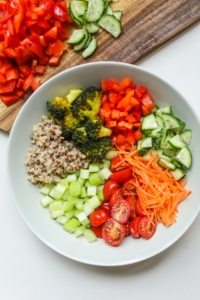
Thank you for taking this information and self-assessment journey toward improving your nutritional habits. We talked about the essential nutrients of vitamins, minerals, fats, proteins, carbohydrates, and water. We’ve given you some food examples to try and a plan for starting your consistency of nutritional habits. Chose one thing to work on over the next two weeks to approach your healthy food goal.
You are strong, capable, and have just taken the first step toward your goal by reading this today.
If you have any questions, or would like to talk with somebody about a more individualized plan toward health, fitness, nutrition, or physical activity, Back in Step Physical Therapy is here for you! Please contact Back in Step PT to schedule an online or in-person consultation today. Make sure to check out our other blogs and follow us on Instagram and for additional tips and tricks from Dr. Alyssa Arms, DPT.
Guest Blog by Haley Tirado, SPT
Haley Tirado is a second year Student Physical Therapist who attends the University of Colorado Anschutz Medical Campus. She completed a work study focused on physical therapy reasearch with the medically complex and total joint replacement patient populations. Haley currently works as an intern for Back in Step Physical Therapy.
Resources
Nutrition and Physical Therapy: A Powerful Combination
Precision Nutrition- Nutrition Coaching Course
How to do Motivational Interviewing: A guidebook
Back In Step Physical Therapy
6551 S Revere Pkwy, Ste 215
Centennial, CO 80111
(303) 960-2075
info@backinsteppt.com
